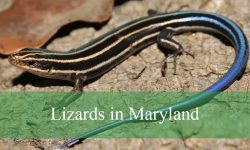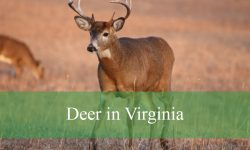Virginia is home to a wide variety of birds, with about 20 species of particularly interesting black birds. The American Crow, a gregarious and intelligent bird, and the secretive Rusty Blackbird, with its glossy black and rusty brown plumage, are just two examples of the many colors and behaviors that these birds use to paint the skies. The area is also frequented by the observant European Starling and the distinctly identifiable Red-winged Blackbird.
Virginia’s black birds add to the state’s natural beauty, whether you’re watching the acrobatics of the European Starlings or following the Rusty Blackbird on its migratory voyage. These resident birds add to Virginia’s wonderful bird watching experiences with their unique characteristics.
Different Types of Black Birds in Virginia
Bobolink
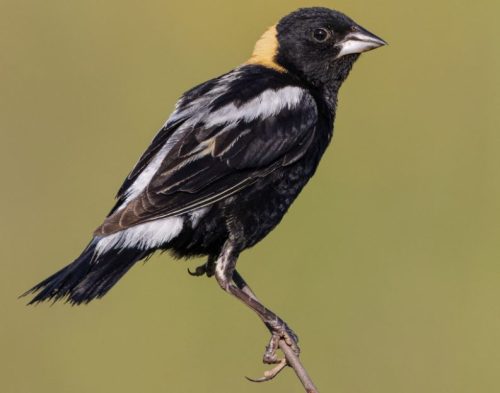
The kind of blackbird that flies over Virginia is the Bobolink, or Dolichonyx oryzivorus. Breeding on the vast fallow fields of southern Canada and the northern United States, it is becoming a rarer species.
Male adults have mostly black feathers with cream-colored caps and white spots on their wings and backs. On the contrary, females and juveniles take on a greater camouflage, with brown above and pale yellow below, and without the characteristic white wing bar.
Males engage in a complex “helicoptering” display in the spring, hovering and singing as they claim territory and court females. Unfortunately, haying too soon during nesting season and habitat loss are contributing factors to the reduction of these migratory birds.
Brewer’s Blackbird
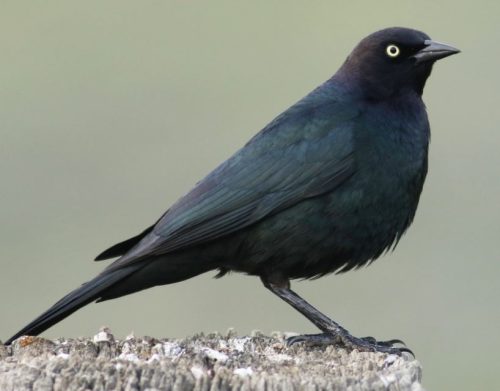
Over much of its range, the Brewer’s Blackbird, technically known as Euphagus cyanocephalus, shows a preference for settings that have been altered by humans. However, this medium-sized blackbird prefers rural locations where competition from the Common Grackle may exist.
Similar to their cousins, Brewer’s Blackbirds congregate in big flocks in the fall to eat the leftover grains from harvested farmlands. They are about the size of a robin and have long tails and legs that, when seated, give them a wider appearance.
Male adults have glossy black feathers that transition from a purple head to a greenish body. Females and juveniles, on the other hand, are uniformly brown with darker tails and wings.
The Brewer’s Blackbird, which can be found in a variety of settings, including urban areas and grasslands, is a comparatively uncommon spring and fall migrant in Virginia.
Brown-headed Cowbird

Within the blackbird family, the Brown-headed Cowbird, or Molothrus ater as it is formally called, is distinct due to its role as a brood parasite. This species, found only in Virginia, does not make nests; instead, it deposits its eggs in the nests of hundreds of other bird species.
Surprisingly, a large number of hosts nurture Cowbird eggs and raise the fledglings as their own. It’s most likely a surrogate raising a Cowbird if you see a little Virginia warbler tending to an unusually huge fledgling.
Males are distinguished by their glossy black bodies and chocolate-brown heads, while females have drab gray-brown colors. Dark-haired Cowbirds live all year round in Virginia. They are accustomed to trailing cattle and buffaloes and eat disturbed insects as food.
These blackbirds travel far during the non-breeding season, frequently congregating in mixed flocks with starlings and other blackbirds to forage on the ground.
Eastern Towhee
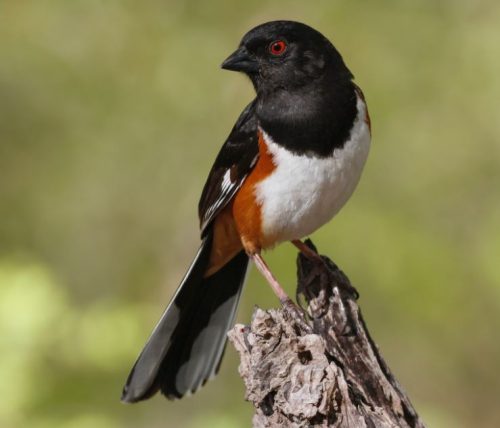
Scientifically referred to as Pipilo erythrophthalmus, Eastern Towhees get their name from the characteristic “Tow-hee” cry that both sexes make. Male Eastern Towhees are not related to blackbirds, but their plumage is primarily black with rusty-brown sides and a white underside. But from some perspectives, their head and back appear completely black, giving the impression that the bird is all black. These towhees have white spots on the upper half of their wings that resemble commas while they fly.
Eastern Towhees in Virginia are red-eyed birds, although there are also white-eyed birds in a few coastal states in the South. Males are in charge of feeding the offspring while females incubate the eggs during nesting. Using both feet at the same time, foraging includes a hilarious backward hopping action that pushes aside leaves to reveal seeds and insects hidden inside.
The Eastern Towhee a year-round resident in southern Virginia; summer visitors are welcomed in the northern region.
Orchard Oriole
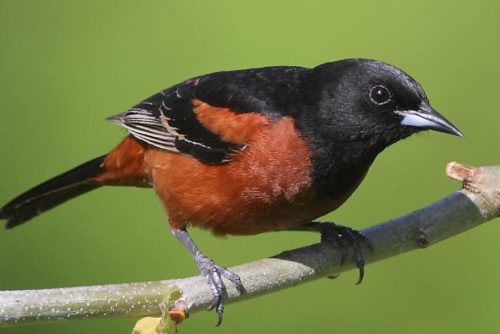
The scientific name for the Orchard Oriole is Icterus spurius, and it got its name because it liked open woods and orchards. It is a summertime visitor to Virginia, mostly seen in the southern region of the state. The dark orange plumage of male Orchard Orioles is distinctive, with black on the head, throat, upper back, wings, and tail; females have dull yellow plumage. During the course of the first two years, young boys gradually change from a color similar to that of females.
Orchard Orioles eat mostly insects in the early summer, switching to natural fruits as they get older. Parent Orioles take their fledged offspring to feeding stations, particularly those equipped with nectar feeders. Although they are less noticeable at feeders and concentrate more on gathering insects for their nestlings, some people erroneously think that the Orioles have left during the height of summer.
The Orchard Oriole is a seasonal visitor that is known to arrive late in spring and depart early in September.
Baltimore Oriole
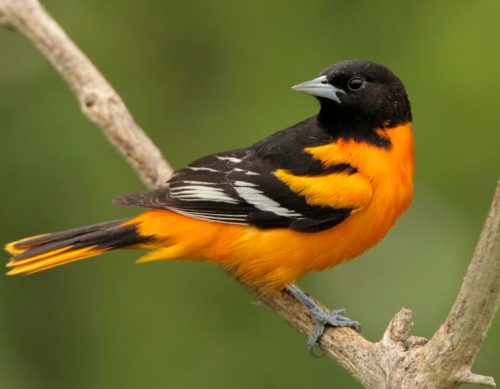
Icterus galbula, the scientific name for the Baltimore Oriole, is a charming songbird that is rarely seen. Male adults draw attention with their bright orange underbelly, which contrasts with their all-black hood and back and one white band on their otherwise black wings. Females and immatures, on the other hand, have a more muted brownish-yellow coloring.
Baltimore Bird feeders filled with orange halves, grape jelly, or nectar are a surefire way to attract orioles. Like Orchard Orioles, parents visit neighboring feeders with their newly fledged offspring. These birds prefer open areas such as parks, yards, and woods, and they frequently visit the same spots year after year. Avoid dense woods and keep a look out for them in deciduous forests. The majority of orioles are mostly heard rather than seen as they forage for insects, fruit, and flowers from high up in trees.
The Baltimore Orioles are one of the last migratory birds to arrive in Virginia in the spring and the first to depart in the fall. They are summer guests.
Yellow-headed Blackbird
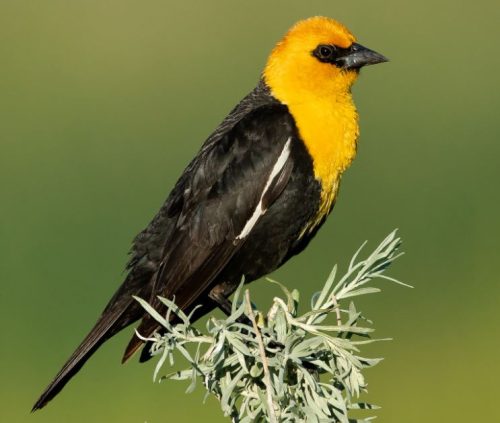
Yellow-headed Blackbirds, scientifically known as Xanthocephalus xanthocephalus, are more commonly found in the western United States, but in Virginia, they appear as rare vagrants during migration season. Adult males are distinctive with their yellow heads and chests contrasted against a jet black body. Conversely, females and immature individuals showcase drab yellow heads and a dark brown coloration instead of black.
Male Yellow-headed Blackbirds frequently create small colonies during the breeding season and mate with several females. Outside of this time, they form large flocks and often mix with other blackbird species when foraging on farmlands’ leftover grains. These blackbirds live in open farmed regions and graze in fields throughout the winter. Their main summertime food source is insects and tiny invertebrates.
Yellow-headed Blackbirds typically breed in lowland areas with wetlands and dense growth of cattails. These blackbirds are mostly seen in Virginia in the fall and spring when they are migrating.
Boat-tailed Grackle
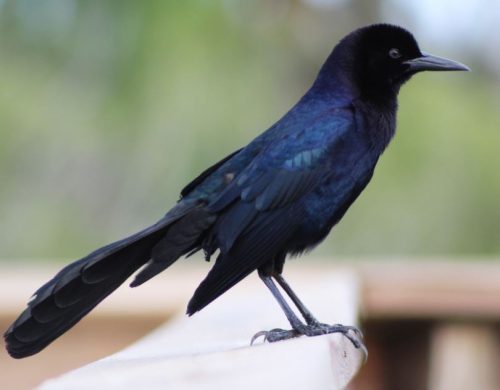
The Boat-tailed Grackle, formally known as Quiscalus major, is larger than the Common Grackle and may be identified by its longer tail, which expands like a spatula at the end. Like other grackles, it is usual for the tail to be folded, with the borders kept higher than the center, much like a keel.
The plumage of adult male Boat-tailed Grackles is completely glossy black and prominently metallic, especially on the head and back. This bird lives all year round along the Virginia coast, mostly in urban parks and marshy areas.
Shiny Cowbird
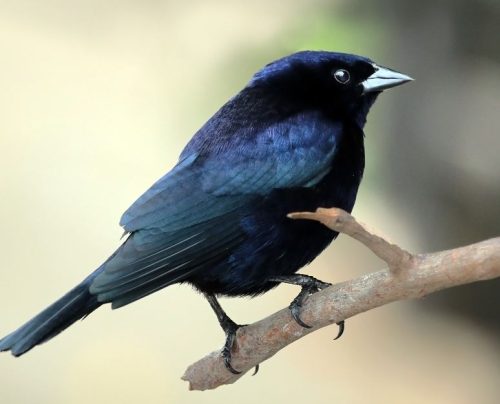
Recent years have seen the establishment of colonies of the blackbird species known as the Shiny Cowbird, or Molothrus bonariensis in scientific parlance, throughout Florida’s coastal regions. These blackbirds are considered vagrants in Virginia and are quite uncommon to see.
Black eyes and a black beak characterize the mostly black adult male Shiny Cowbird, which has a glossy purplish shine. The color of young birds is light brownish-gray, whereas females are brown in color. Like Brown-headed Cowbirds, Shiny Cowbirds take advantage of other bird species’ nests as a place to lay their eggs instead of building their own.
This blackbird’s eggs are deposited in the nests of numerous bird species, and the young Shiny Cowbirds typically leave their host’s nest within two weeks.
Open woodlands, backyards, and parks together with open agricultural areas are frequent locations for Shiny Cowbirds. It is omnivorous, just as other species of blackbirds, mostly feeding on insects and other tiny invertebrates in the summer and switching to seeds in the winter.
Eastern Meadowlark
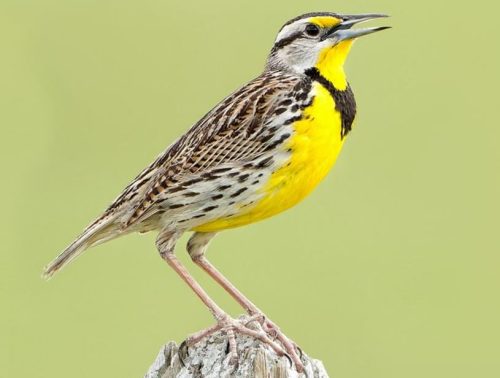
With a conical beak and a short tail, the Eastern Meadowlark, scientifically known as Sturnella magna, is a colorful ground-foraging bird that is perfect for gathering seeds and insects. Males sing while in flight or from elevated perches to mark their territories throughout the breeding season. Eastern Meadowlarks are either year-round residents or seasonal visitors, depending on the area. They are spotted all year long in Virginia.
The adult Eastern Meadowlark has vivid yellow underparts with a jet black V on the chest and light brown upperparts with black markings. These birds, which are frequently hidden by plants, feed on the ground in farms, wet fields, and grasslands. There are habitats that are suitable for raising a family.
Males whistle beautifully and melancholically in the summer on exposed perches, especially fence posts.
Bullock’s Oriole
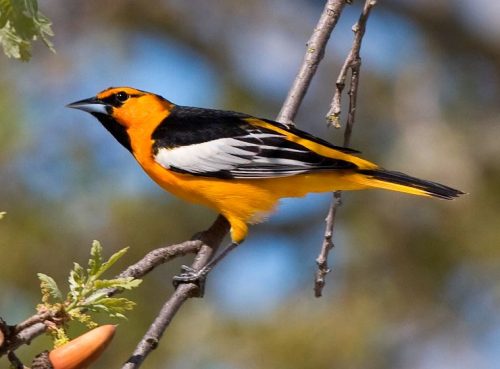
Icterus bullockii, the scientific name for the Bullock’s Oriole, is a rare summertime vagrant visitor to Virginia. Male adults have brilliant orange feathers with a huge white wing patch, jet black neck and back. They have an orange face and a black throat. With orange on their face and chest, juveniles and females have a more grayish-yellow tone. Wintering in Mexico, they are native to the western United States.
Bullock’s Orioles graze on the top branches of trees and shrubs, looking for fruits and insects. They can be encountered in parks, orchards, open forests, and areas close to rivers and streams.
Common Gallinule
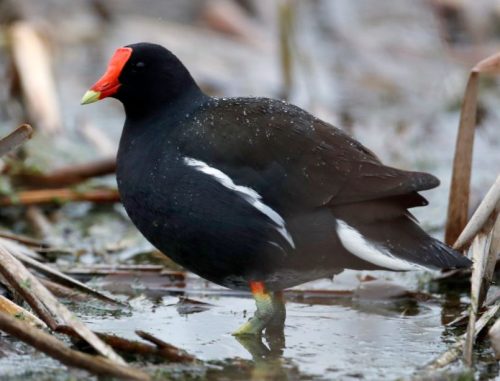
The medium-sized marsh bird known as the Common Gallinule, or Gallinula galeata in scientific parlance, is easily identified by its long, green appendages. The bodies of both sexes are charcoal black with a white stripe running down the side, and the outer tail feathers are white as well.
Like ducks or geese, Common Gallinules are proficient in the water and have the ability to walk atop floating vegetation. When they move, they usually assume a crouched posture and twitch their tail periodically. Though they may swim in open water, they prefer the cover provided by marsh vegetation.
These birds do well in ponds, marshes, and lakes that have a combination of open water and aquatic plants. When they are foraging, they enter ditches and canals. Common Gallinules are comparatively rare summer visitors to Virginia, nesting in marshes and lakes.
American Coot
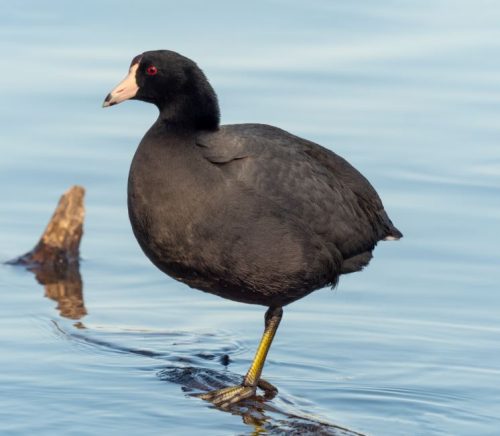
Large flocks of American Coots (Fulica americana) are regularly observed congregating on open water, especially during migration. Their colors range from dark gray to black, and they have a red eye that stands out along with a white beak and forehead. These waterfowl have wide, lobed toes instead of webbed feet, like ducks do.
American Coots are skilled surface swimmers, but they are also skilled divers; they frequently search the bottom of small lakes and ponds for food. Sadly, Bald Eagles prey on them, wearing them out by making them dive repeatedly until they are exhausted.
Urban park ponds, marshes, lakeshores, and reservoirs are just a few of the aquatic habitats that these birds prefer. Perched above nearby vegetation, their nests are platforms that float. Although American Coots breed mainly in the north, they winter in Virginia or migrate there.
American Crow
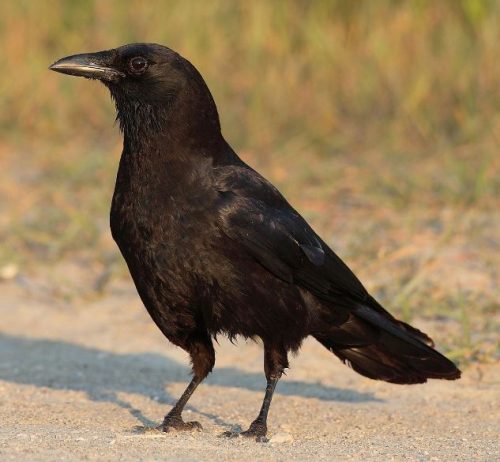
The American Crow, scientifically known as Corvus brachyrhynchos, is a large, entirely black bird found in Virginia, with black beaks, legs, and eyes, making adults and immature birds indistinguishable. Renowned for its intelligence and sociability, this bird engages in playful harassment of other birds.
Nesting in trees, the American Crow constructs large stick nests reused for many years, often adopted by various birds, including raptors and owls in Virginia. Like vultures and birds of prey, they feed on roadkill but seldom fall victim to cars. Beyond the breeding season, these crows form massive flocks, sometimes numbering in the thousands.
Easily recognizable in Virginia, American Crows are common in open forests, woodlands, farmland, and urban areas, including parks, golf courses, and large gardens. Family groups sleep together at night but disperse during the day for foraging.
Red-winged Blackbird
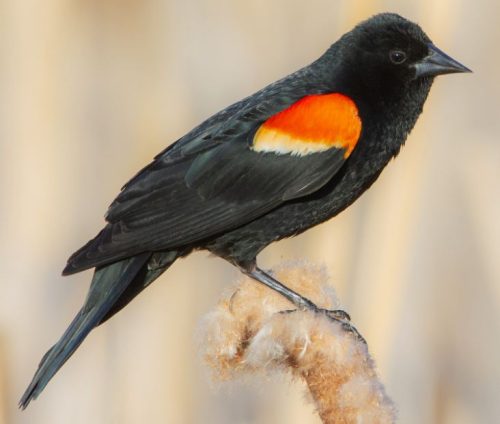
The Red-winged The blackbird, scientifically known as Agelaius phoeniceus, is the most prevalent blackbird in Virginia in the summer, particularly in open fields and wetlands close to bodies of water. Males can be easily identified by their brilliant red wing patches and black bodies, while females and juveniles have white streaks on their blackish brown bodies. They travel great distances every day, mostly living near lakes, wetlands, and marshes.
While primarily seed-eaters in fall and spring, they shift to an insect-focused diet in summer. Depending on location, they are either seasonal migrants or residents. Roosting in massive flocks, their rapid wing beats create a deafening noise. During mating season, males arrive early, claiming territories with conspicuous singing and displays of red shoulder patches to attract females.
Mating involves the female choosing a mate, building nests over shallow water, and the chosen male defending against other blackbirds. Successful males can be bigamous, mating with multiple females simultaneously.
Common Grackle
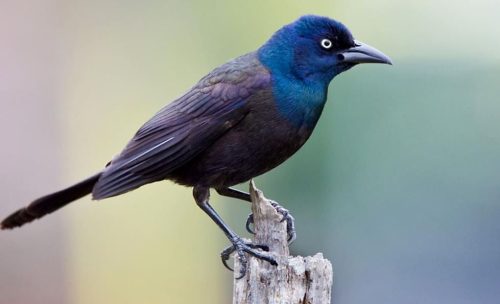
The Common Grackle, scientifically known as Quiscalus quiscula, may appear entirely black from a distance, often leading to confusion with crows. However, distinct features include a cone-shaped pointed beak, bright yellow eyes, and a wedge-shaped long tail. In Virginia, it inhabits open spaces like meadows, parks, fields, suburban, and residential areas.
The shimmering purple coloring of the heads, breasts, necks, and other body parts is characteristic of male common grackles. When they are nesting, females build enormous nests that hold around five eggs each. Although it migrates throughout the summer months in the northern range, it is a year-round resident in Virginia.
Common Grackles are a member of the New World blackbird family and are renowned for congregating in loud, gregarious flocks. By gathering in large groups on fields and feasting on grains and crops, they can pose a threat to Virginia’s farmers. The Common Grackle’s adaptability enables it to flourish in a variety of settings.
European Starling (Common Starling)
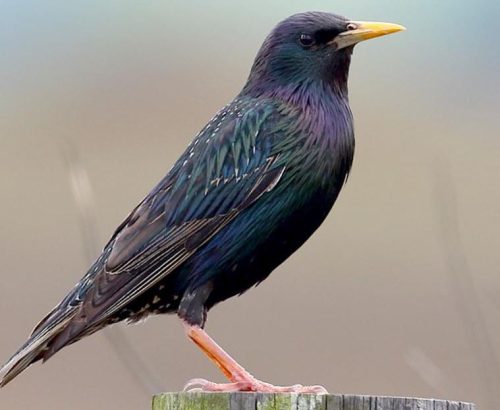
The European Starling, scientifically named Sturnus vulgaris, is a prevalent and highly successful bird in Virginia. Despite not belonging to the blackbird family, adult starlings have a uniformly glossy black appearance, resembling other blackbirds. In winter, they develop light spots, aiding in identification.
Originally from Europe, Asia, and North Africa, the European Starling was introduced to North America and various global regions, establishing itself as a successful breeder in a short time. While their original habitat is open areas with few trees, they thrive in urban environments, particularly in parks and gardens.
Nesting in tree holes in the wild, European Starlings also nest inside buildings and boxes in urban settings, sometimes displacing native birds. Like grackles and other blackbirds, they form large flocks outside the nesting season, showcasing incredible aerial acrobatics with flocks exceeding a million birds.
Rusty Blackbird
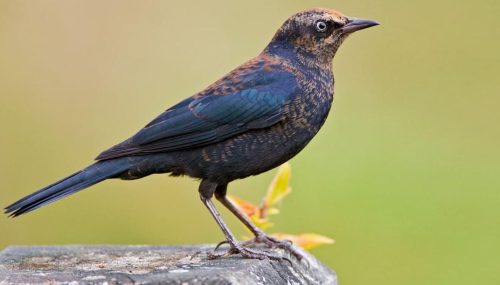
Compared to several other members of the blackbird family, the Rusty Blackbird, technically known as Euphagus carolinus, presents less of a threat to agricultural operations. Its breeding in isolated, uncultivated, swampy places is the cause of this. Male adults have glossy black plumage; females and juveniles have brownish-gray coloration.
Male Rusty Blackbirds change color during the fall, becoming a dull rusty brown. They are mostly seen in Virginia in the fall when they go from their nesting grounds in Canada south for the winter, passing through the state in large numbers. Many migrate in the fall and spring, but others stay in Virginia all winter, and they can be seen from September to the end of April.
People Who Read This Also Read:





